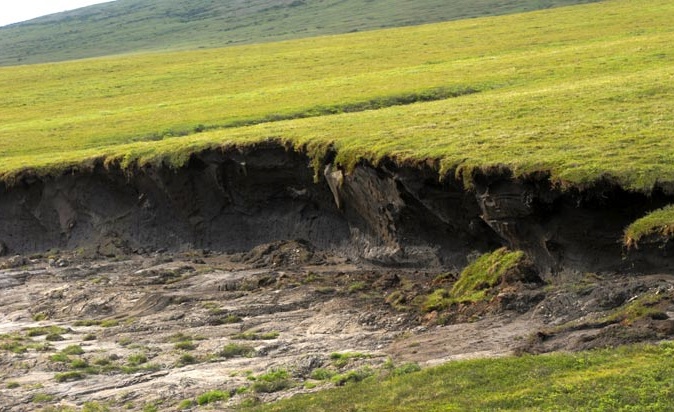That’s right. Slumping thermokarst. Essentially thawing coastal permafrost in the arctic:
 A new paper in PNAS describing work by my UNC colleague Dr Rose Cory in Alaska on thermokarst slumping is shaking up the world of thermokarst experts and alarming thermokarst conservationists and collectors. But seriously, this is just one more sign of a positive feedback of global warming; the more it warms, the more CO2 gets released from natural sinks, amplifying the warming, and round and round it goes.
A new paper in PNAS describing work by my UNC colleague Dr Rose Cory in Alaska on thermokarst slumping is shaking up the world of thermokarst experts and alarming thermokarst conservationists and collectors. But seriously, this is just one more sign of a positive feedback of global warming; the more it warms, the more CO2 gets released from natural sinks, amplifying the warming, and round and round it goes.
The excerpted piece describing Rose’s work below is from ScienceNow:
Each spring in the Arctic, the freshet—flooding triggered by melting snow—washes vast amounts of carbon-rich soil from the land into the water—both fresh water and the ocean. That’s of particular interest to scientists studying global warming, because in those waters much of the carbon that’s being released from melting permafrost is oxidized by bacteria into carbon dioxide, says Rose Cory, an environmental scientist at the University of North Carolina, Chapel Hill. Carbon from surface waters amounts to as much as 40% of the total carbon that ultimately gets transferred from the Arctic to the atmosphere, she says.
But little research has been done on the transformation of organic carbon in Arctic waters into carbon dioxide. Instead, much of the work on permafrost degradation over the past few decades has focused on the widespread, slow melting of the icy soils from the top down, says Vladimir Romanovsky, a geophysicist at the University of Alaska, Fairbanks, who was not involved in the new study. Reports on the state of the Arctic, such as the National Oceanic and Atmospheric Administration’s 2012 Arctic Report Card, published in December, furnish Arctic temperatures and measurements of the changing thickness of the active layer of the permafrost, the layer of surface soil that melts and refreezes each year.
That melting does transfer carbon into surface waters, but scientists have recognized in recent years that there’s much more to the permafrost story, Romanovsky says. As melting has progressed in the Arctic, large holes and landslides have popped up across the tundra. In permafrost, ice holds up the soil; when the ice melts, the land surface slumps, creating features known as thermokarst failures.
Compared with the slow, top-down melting of permafrost, thermokarst failures unleash rapid bursts of carbon-rich organic material, as rivulets of water from the melting ice cut deep channels into the soil and transport the carbon into rivers or the ocean. What happens to those gushes of carbon has not been well studied, Cory says.
So she and her team collected samples of water trickling out of seven Alaskan thermokarst failures into nearby lakes and streams. They analyzed the samples for colored dissolved organic matter, which contains light-absorbing molecules from the breakdown of plant polymers such as lignin. “The general idea is that the closer to the terrestrial source, the more color the carbon will have,” Cory says. At six of the sites, the team also irradiated the samples with ultraviolet (UV) light, mimicking the effects of sunlight.
To their surprise, the researchers found that the samples from the thermokarst sites had lower levels of colored dissolved organic matter than did reference sites, suggesting that the carbon in the deeper soils exposed by thermokarst failure is significantly different from the carbon draining from the topmost, active layer of the permafrost, the team reports in the Proceedings of the National Academy of Sciences. When the team determined what happened to that carbon under UV light, they found that the deeper carbon was also about 40% more susceptible to photochemical and biochemical degradation into CO2 than was carbon from the active layer.
“What it means is that the carbon coming out of these sites is more reactive” than the carbon draining from the active layer of permafrost, Cory says. “[So] there is potential that these tremendous stores of carbon in these soils can be a positive feedback for more warming.”
It’s an important study, Romanovsky says. “[Thermokarst failure] is kind of a shortcut for the involvement of this frozen carbon in the present climate and the carbon cycle, and that’s recognized very well right now,” he says. “People are really starting to pay serious attention.”
Understanding the transformations of the carbon in Arctic waters—including the paper’s finding that exposure to light accelerates the decomposition—will be key to understanding the effect on climate, he adds.
Cory says that the team is now working on scaling up their findings. But with thermokarst data still sparse, it’s a challenge to know how widespread the effect is. In a few areas—parts of Alaska and some patches in Siberia—scientists have begun doing more thorough analyses on thermokarst, Romanovsky notes. “But these features are still very localized,” he says, “and the question of how important this is for the entire northern hemisphere is still unclear.”
Leave a Reply